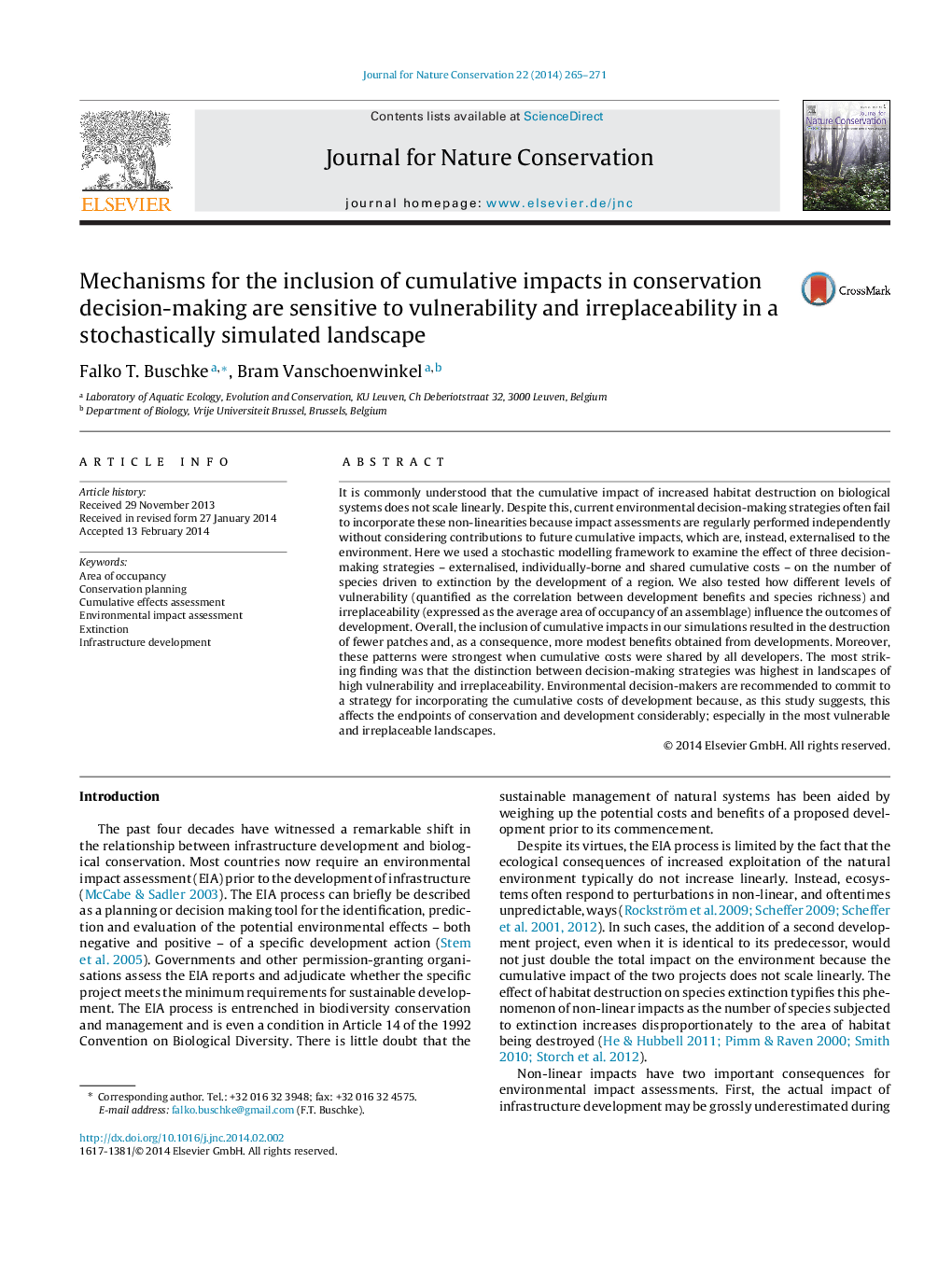| کد مقاله | کد نشریه | سال انتشار | مقاله انگلیسی | نسخه تمام متن |
|---|---|---|---|---|
| 4399819 | 1306886 | 2014 | 7 صفحه PDF | دانلود رایگان |
عنوان انگلیسی مقاله ISI
Mechanisms for the inclusion of cumulative impacts in conservation decision-making are sensitive to vulnerability and irreplaceability in a stochastically simulated landscape
ترجمه فارسی عنوان
مکانیسم های برای درج اثرات تجمعی در تصمیم گیری در مورد حفاظت از حساسیت به آسیب پذیری و غیر قابل تعویض در یک منظر شبیه سازی تصادفی
دانلود مقاله + سفارش ترجمه
دانلود مقاله ISI انگلیسی
رایگان برای ایرانیان
کلمات کلیدی
محدوده اشغال، برنامه ریزی حفاظت، ارزیابی اثرات تجمعی، ارزیابی اثرات زیست محیطی، انقراض، توسعه زیرساخت ها،
ترجمه چکیده
معمولا تصور می شود که اثر تجمعی کاهش تخریب زیستگاه در سیستم های بیولوژیکی خطی نیست. با وجود این، استراتژی های تصمیم گیری در حال حاضر محیط زیست اغلب شکست این ترکیبات غیر خطی را در بر می گیرد زیرا ارزیابی های به طور مستقل بدون مشارکت در تأثیرات تجمعی آینده صورت می گیرد که در عوض به محیط زیست خارجی منتهی می شود. در اینجا از یک چارچوب مدل سازی تصادفی برای بررسی تأثیر سه استراتژی تصمیم گیری - هزینه های اضافی، جداگانه و مشترک تجمعی - بر تعداد گونه هایی که منجر به انقراض توسعه یک منطقه می شوند، استفاده می شود. ما همچنین آزمایش کردیم که چگونه سطوح مختلف آسیب پذیری (که به عنوان همبستگی بین مزایای توسعه و غنای گونه) و غیر قابل تعویض (بیان شده به عنوان میانگین مساحت اشغال یک مجموعه) را تحت تاثیر قرار می دهند بر نتایج توسعه تاثیر می گذارد. به طور کلی، افزودن تأثیرات تجمعی در شبیه سازی های ما منجر به تخریب تکه های کمتر و در نتیجه مزایای منفی بیشتری از پیشرفت ها شد. علاوه بر این، این الگوها قوی ترین زمانی بود که هزینه های تجمعی توسط همه توسعه دهندگان به اشتراک گذاشته شد. قابل توجه ترین یافته این بود که تمایز میان استراتژی های تصمیم گیری بیشتر در مناظر آسیب پذیری بالا و غیر قابل تعویض بود. تصمیم گیرندگان محیط زیست توصیه می شود تا به یک استراتژی برای ترکیب هزینه های تجمعی توسعه بپردازند چرا که، همانطور که این مطالعه نشان می دهد، این به طور قابل ملاحظه ای بر پایه های حفاظت و توسعه تاثیر می گذارد؛ به ویژه در مناظر آسیب پذیر و غیر قابل تعویض.
موضوعات مرتبط
مهندسی و علوم پایه
علوم زمین و سیارات
علوم زمین و سیاره ای (عمومی)
چکیده انگلیسی
It is commonly understood that the cumulative impact of increased habitat destruction on biological systems does not scale linearly. Despite this, current environmental decision-making strategies often fail to incorporate these non-linearities because impact assessments are regularly performed independently without considering contributions to future cumulative impacts, which are, instead, externalised to the environment. Here we used a stochastic modelling framework to examine the effect of three decision-making strategies - externalised, individually-borne and shared cumulative costs - on the number of species driven to extinction by the development of a region. We also tested how different levels of vulnerability (quantified as the correlation between development benefits and species richness) and irreplaceability (expressed as the average area of occupancy of an assemblage) influence the outcomes of development. Overall, the inclusion of cumulative impacts in our simulations resulted in the destruction of fewer patches and, as a consequence, more modest benefits obtained from developments. Moreover, these patterns were strongest when cumulative costs were shared by all developers. The most striking finding was that the distinction between decision-making strategies was highest in landscapes of high vulnerability and irreplaceability. Environmental decision-makers are recommended to commit to a strategy for incorporating the cumulative costs of development because, as this study suggests, this affects the endpoints of conservation and development considerably; especially in the most vulnerable and irreplaceable landscapes.
ناشر
Database: Elsevier - ScienceDirect (ساینس دایرکت)
Journal: Journal for Nature Conservation - Volume 22, Issue 3, June 2014, Pages 265-271
Journal: Journal for Nature Conservation - Volume 22, Issue 3, June 2014, Pages 265-271
نویسندگان
Falko T. Buschke, Bram Vanschoenwinkel,
